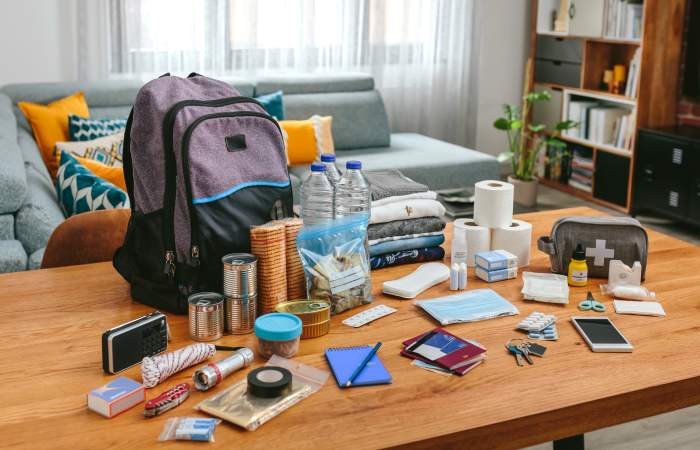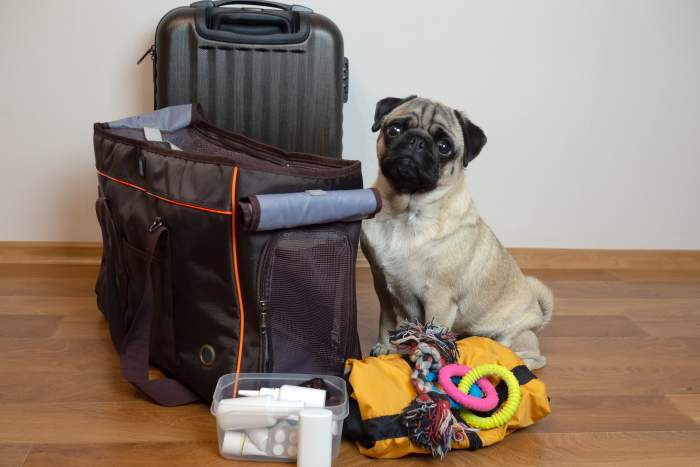Being prepared can make all the difference in an emergency. The Emergency Preparedness Guide provides practical steps to help Londoners prepare for and respond to emergencies such as severe weather, flooding, power outages, and evacuations.
Make a Plan
Emergencies can strike with very little warning, leaving you with no time to make plans about where to go and what to do.
Challenges you might face in an emergency:
- You might not have the opportunity to gather resources that you need
- Family members may be in different locations when the event occurs
- Communication networks can break down
- It is possible that electricity, water or gas service to your home will be disrupted
- Roads could be blocked or closed
- Regular sources of food, water and gasoline might not be available
Residents have a key role to play in responding to emergencies. Make plans to be able to take care of yourself and the members of your household for a minimum of three days.
Being prepared ahead of time will help you and your family cope with an emergency more effectively and enable you to make a faster recovery.
Emergencies can be particularly stressful for children, seniors and individuals with disabilities or special needs. They may feel especially vulnerable if they rely on caregivers for assistance but are separated from them when the incident occurs. If your household includes a person who requires extra help or has special needs, be sure to include provisions for them in your plan.
Prepare a Kit
Make preparations before an emergency to be self-sufficient for a minimum of three days. This allows emergency workers to focus on people who require urgent assistance. Assemble an emergency kit that contains items to help you cope for a minimum of three days during an emergency. Store the items in backpacks, duffel bags or luggage so you can easily take the kit with you in case you need to evacuate. Keep it in a cool, dry area of your home. Ensure that every household member knows where the emergency kit is located. You should prepare a:

- Household emergency kit
- Vehicle emergency kit (if required)
- Pet emergency kit (if required)
- Car emergency kit (if required)
- Apartment emergency kit (if required)
Check your kits at least once each year. A good time to inspect it is during Emergency Preparedness Week. Check that all items are in working order and use your checklist to ensure that your kit is still complete. Replace food, water and batteries in your kit at this time.
Emergency kit checklist
Make sure your emergency kit contains the following:
- Flashlight and batteries
- Radio and batteries or crank radio
- Spare batteries
- Family first aid kit
- Candles and matches/lighter
- Extra car keys and cash
- Important papers (identification)
- Clothing and footwear
- Blankets or sleeping bags
- Toilet paper and other personal items
- Medication, spare glasses and aids
- Whistle (to attract attention, if needed)
- Playing cards, games and toys
- Manual can opener and bottle opener
- Map of the City
- Duct tape and plastic sheeting
- Corded telephone (non-electricity dependent)
- Pet food and supplies
- Pocket knife or multi tool
- Container, backpack or bag for your kit
- Cook stove, lantern and fuel (follow manufacturer’s instructions – never use barbeque inside)
- Disposable cups and plates, knives, forks and spoons
- Bottled water: at least four litres per person, per day – two for drinking and two for food preparation, hygiene and dishwashing. Keep a supply of water purification tablets on hand as well.
- Food for three days per person. Choose ready-to-eat foods that your family likes and doesn’t require refrigeration such as canned foods, crackers and biscuits, honey, peanut butter, syrup, jam, salt and pepper, sugar, instant coffee and tea. Note: consume and replace canned and dry goods once a year.
Grab and go bag
If you are asked to evacuate to a reception centre, or family/friend’s residence, bring with you:
- Clothing and footwear
- Prescription drugs (check dates/rotate supply)
- ID and/or photos of family
- Important papers such as insurance, phone contacts, certificates and health cards
- Personal care items
- Hand sanitizer
- Non-perishable healthy snacks
- Playing cards and games
- Baby supplies and diapers
- Duffel bag or backpack for kit
Pet emergency kit
If you have a pet, make sure you have an emergency kit that includes the following:
- Include at least three days of pet food and water supplies
- Bowls and medications
- Paper towels
- Can opener
- Blanket
- Small toy
- Sturdy leash, harness, collar
- Cat litter pan and plastic bags
- Carrier for transportation and/or crate
- Medical-vaccination records
- Current photo
- Up-to-date ID tag and copy of muzzle licence if required
- Have recorded details of eating schedule, medical or behavioral problems for your pet if they need to be boarded
- Emergency contact information
Vehicle emergency kit
If you own a vehicle, make sure you have an emergency kit that includes the following:
- Batteries
- Flashlight
- Radio or crank radio
- Vehicle first aid kit, safety seatbelt cutter
- Candles and matches or lighter
- Booster cables and tow chain/rope
- Fire extinguisher (ABC type)
- Tire pump/inflator and tire gauge
- Gas container, vehicle fluids, survival blankets, hot packs
- Loud whistle, emergency/help sign
- Emergency food/water
- Emergency fares and safety triangle
- Shovel, multi tool, snow brush/scraper
- Sand, salt or kitty litter, traction mats
- Compass, road maps paper towels or cloth
Apartment emergency kit
In addition to the household emergency kit items, make sure your apartment emergency kit includes the following:
- Building manager or superintendent contact information
- Personal alarm (or whistle) to draw attention to your whereabouts
It is also important to know where all escape routes and location of emergency doors and exits are on each floor.
Pets and evacuations
If there is an evacuation order, pets should not be left behind for risk of getting lost or injured. Make sure to plan ahead and have a place your pet can go if an evacuation occurs.

- Check with hotels and motels in your area and out of town for what their policy is on pets and if they will be accepted during emergencies
- Check with friends and family members to see who would be able to house your pets if needed during an emergency
- Make sure to include your pets in all drills and exercises
What to do if you are not home and an evacuation is ordered? If you are not home during an evacuation ordered, you should have a plan in place with a friend or neighbour to get your pet and their emergency kit, ensuring your pet will be able to be evacuated and find safety during an emergency.
Download the PDF fact sheet here.
Emergency preparedness for seniors
Your emergency plan should have the following:
- Two safe locations for you to go to during an evacuation order. One within your community nearby and one outside of your neighbourhood if the emergency affects a larger area
- Family Communication Plan. During an emergency, local telephone and network lines may be down causing you not to be able to contact family. It is good to identify an out-of-town contact who may not be affected by the outage and who can share information as needed
- A list of individuals in your support network who will be able to help you during an emergency when its needed
- Enlist a neighbour or friend to check in with you or grab your emergency kit during an emergency
- If you have any special needs for evacuation, make sure that this is known. Make sure you let your family know of your plans when it comes to preparedness. Also ensure your family knows your evacuation plan
Make sure you also consider your living situation when looking at evacuation plans. Living in a high-rise building calls for a different evacuation plan than a single floor dwelling. Make sure you inform your building manager of any assistance you need if there is an evacuation. Building managers are required to keep a list of individuals who will need assistance when evacuating.
In your emergency kit, make sure to consider these special items:
- Medical supplies and equipment (hearing aids, walker, cane, breathing device)
- Dentures and supplies
- Prescription eyewear and footwear
Make sure to have your items ready to go in case of evacuation.
Self-care during emergencies
Self-care is not only important in your daily lives. When emergencies happen, this can be stressful and challenging. Managing stress daily can help strengthen resilience and help us cope in times of emergencies. Everyone responds to stress differently. Identifying your stress response and building a self-care plan can help when it comes to emergencies.
Self-care plan
Building a self-care plan may take some time but it can be helpful to your well-being. You can make as many changes to your self-care plan as you need.
Think about your current self-care plan and how your wellness strategies may change during an emergency.
Self-care practices
Some practices for your self-care plans include:
- Your Emotional Stressors – plans to overcome this include talking about your emotions, journaling, having a positive outlook and more
- Your Body Stressors – plans to overcome this include going into nature, praying, connecting with your community, meditating and more
- Your Mind/Psychological Stressors – plans to overcome this include journaling, therapy, meditation, self-reflection and more
- Your Spirit Stressors – plans to overcome this include going into nature, praying, connecting with your family, meditating and more
- Your Professional Stressors – plans to overcome this include taking your full lunch break, using your vacation days and more
- Your Home Stressors – plans to overcome this include making goals, practicing hobbies, getting coffee/tea with friends, going on a date and more
Now, how would your plan change during an emergency? Think about how you can continue with your self-care plan and what may need to be changed. Also think about how it would change if you had to be evacuated from your home. What would this look like?
Identify Supports and Social Network
Creating a positive social network can help with self-care and resilience during stressful times. Social supports can come from family members, friends, neighbours, professionals, clubs and organizations, faith-based groups, and workplaces.
Make a self-care kit for your emergency kit
This will be a small kit that will fit inside of your emergency kit to help with self-care during an emergency or evacuation. Make sure to include a copy of your emergency self-care plan for you to reference.
Emergency self-care kit
Items to consider that help with grounding your senses include:
- Stress balls
- Your favourite book
- Fuzzy socks
- Photos of loved ones
- A stuffed animal
- Colouring books
- Your favourite tea or snack
- Fidget toys
- Essential oils
Even during emergencies, self-care can help to alleviate your stressors, take care of yourself, and allow you to be more resilient. When using methods of self-care, try to use the methods that best help you. Some self-care methods could work well for some people, but may not have the same effect on you and your mental health.
